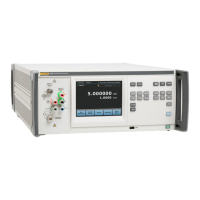Remote Commands
Using Commands 6
6-5
Using Commands
Communication between the controller and the Product consists of interface
messages and commands. Interface messages are defined by the IEEE-488.1
standard and control the lowest level of bus communication. Interface messages
are handled automatically by the controller. (See "Interface Messages" further on
in this chapter for more information.) The commands are described in this
chapter. Command types are:
• Common commands: Commands that start with an asterisk. These are
defined by the IEEE-488.2 standard.
• Device-dependent commands: Commands specific to the Product.
• Queries: Commands that cause the Product to send a response to the
controller. These commands always end with a question mark (?).
Table 6-6 summarizes the commands by function. The command descriptions
provide protocol details of the remote commands.
The commands duplicate almost all activities that can be initiated from the front
panel in local operation. Separate headings for each command in the tables
provide the parameters and responses (if any), and an example for cases in
which the parameters are not self-explanatory.
Multiple Commands
Controllers may send commands all at once, or one at a time. For example, if
you want take a reading on INPUT 2, you can send these two commands:
INPUT INPUT2 <CR/LF>
MEAS? <CR/LF>
You can combine the two commands as a compound command in one statement
as follows:
INPUT INPUT2;MEAS? <CR/LF>
Sequential and Overlapped Commands
Commands executed immediately as they are encountered in the data stream
are called sequential commands. Commands that begin execution, but are
completed later are called overlapped commands, because they can be
overlapped by later commands. All the commands described in this chapter are
sequential unless it is stated otherwise in the alphabetical listings.
You can use *OPC, *OPC?, and *WAI to detect completion of overlapped or
long-term commands. (See the full descriptions of *OPC, *OPC?, and *WAI in
this chapter for more information about these commands.)

